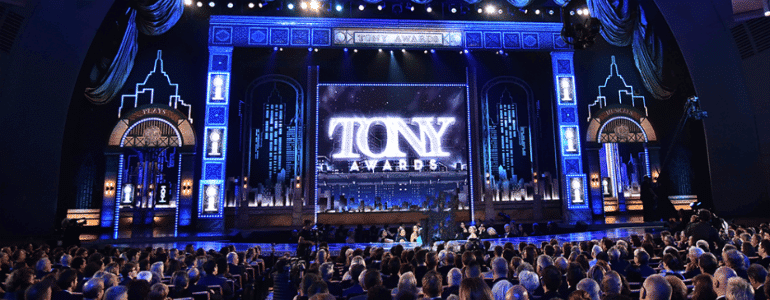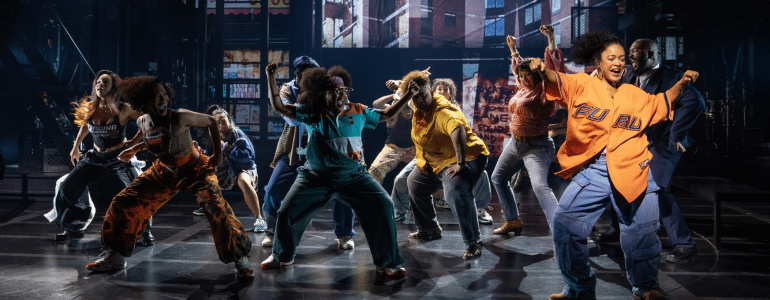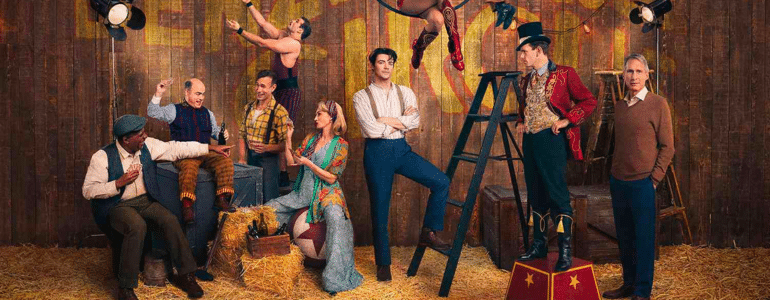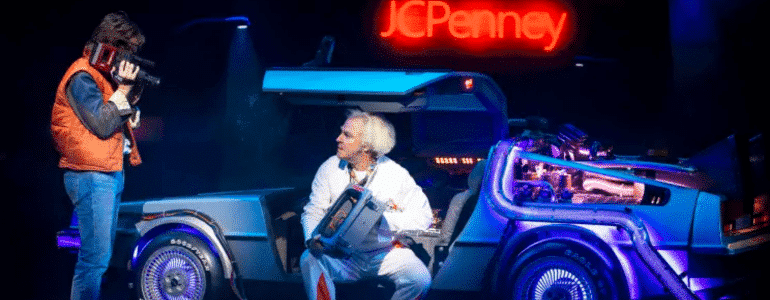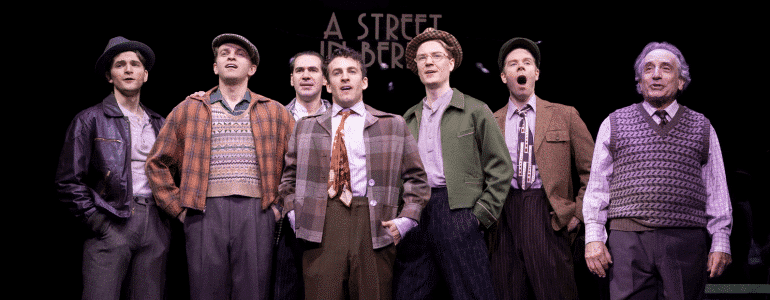Podcast Episode 79 – Bartlett Sher
Ken: Hello, everybody. This is the Producer’s Perspective Podcast; I am Ken Davenport. I am very excited to have on today’s podcast the man responsible for some of the biggest, most breathtaking productions of the last decade – Tony award winning director Mr. Bartlett Sher. Welcome, Bart!
Bart: Hi.
Ken: So some of those productions I’m talking about include this season’s Fiddler on the Roof as well as last season’s Tony award winning The King and I, the Tony award winning South Pacific as well as The Bridges of Madison County, which I was fortunate enough to be a producer on, The Light in the Piazza, Awake and Sing, Golden Boy, a ton more. The New York Times actually called Bart “one of the most original and exciting directors not only in the American theatre but also in the international world of opera.” He is also the resident director at Lincoln Center, where we are right now. Bart, so where did you get bit by the theatre bug? How did this begin for you?
Bart: Well I had the very unusual circumstances of growing up in San Francisco in the ’60s and ’70s where life was tumultuous, where I came from a large Catholic family – my father was Jewish, my large Catholic family – in which the world was in a great deal of transformation, so there were riots in the streets, there were crazy things happening, there was political upheaval from Vietnam. I had brothers who were very adventurous in my childhood and much older than I was so I watched them go through a lot of things and one of the great things my brothers did was when I was, I think, 10 or 11 years old – they took me to what I would consider my first great theatrical experience, which happened to be a concert of the Grateful Dead at Winterland Arena where I watched the Bacchic ritual of 5,000 young people taking more risks in the audience than they were taking onstage, engage in an incredibly wild performance piece in a weird interaction between the band, the audience and the sort of live visual world that was being created with overheard projectors and weird stuff and I fell into an interest in music and art and I grew up in a very cultural city where I got to see symphony music next to Grateful Dead next to theatre at ACT that was run by Bill Ball at that time. So I had a kind of crazy upbringing mixed with a great deal of political upheaval and a great feel of transformation and a lot of people taking drugs and things around me which forced you to see the world differently. There was also the rise of the gay community at that time so there was a ton of stuff going on in my young eyes as I grew up and I think that led me to an appreciation or a perception of the world which was unique, perhaps, challenging and interested in possibly different levels of adventure.
Ken: And why directing? Why was that the avenue that you wanted to take instead of performing or, frankly, fronting a ’60s band?
Bart: Well I didn’t really start in directing. I went to a fairly conventional liberal arts Catholic college on the east coast, even though I grew up on the west coast. It was a Jesuit school, I went to Jesuit college, I went to a Jesuit high school, and I really probably had more interest in becoming a writer than a director. I found myself as an English major – I started as a philosophy major but switched to English. I had travelled a bit around the world; I had been to Europe, I had done some other things – I earned the money to go to Europe to visit my brother at one point so I was kind of expanding my sense of art and things like that but I wanted to be a writer and in my senior year of college I wrote a play that I somehow talked everybody into producing on the main stage of the school. The play was called Fish Every Day. It was kind of a weird thriller/crazy indictment of Catholicism and Catholic colleges and it was quite cause célèbre in my community and it was fun to do and it nurtured my interest in making theatre. It wasn’t until after I got out of college that I convinced my old high school – back in San Francisco now – to hire me to teach English, because I was an English major, and to run the drama department. There was absolutely no reason they should have believed me but they gave me a theatre and I was 22 years old and they said “Here’s the play that you have to do first,” and I said “Great,” and I actually did the lighting and that’s where I started. So I’ve actually been directing, as a result, since that time for something like 34 or 35 years straight. After that point I got very involved in experimental theatre because of my interest in the Grateful Dead and things like that and one of my great influences growing up was something called the Olympic Arts Festival in 1984 where, for some reason, all of the great European, and actually from Asia, theatre companies came to Los Angeles so I saw Giorgio Strehler, who was a huge influence on me, from the Piccolo Teatro, Ariane Mnouchkine from France and this amazing guy named Tadeusz Kantor, who was a Polish avante garde theatre artist, and I just immersed myself in all of these influences and soon after that I moved to San Diego and built my own theatre company and then I decided to go to graduate school in England where I studied African theatre and I really went through a big developmental period that was both classical and, eventually, was both experimental first and then became more classical because after this long investigative period in England and here I was hired to be the resident director of the Guthrie Theatre in the early ’90s with Garland Wright and that sort of kicked me into the more traditional vein of theatre.
Ken: And then you spent some time in Seattle, right?
Bart: After the Guthrie I then worked at Hartford Stage under Mark Lamos as an associate director, I did lots of freelancing and then eventually was angling towards becoming an artistic director and eventually the place I convinced to hire me was the Intiman Theatre in Seattle. I had already done a ton of work up to that point but I then took a body of work into the Intiman and sort of produced that and worked for Theatre for A New Audience here in New York and we did stuff at the RSC and bounced back and forth. My big, first, huge New York Broadway job was The Light in the Piazza.
Ken: And did you always have your eyes set on New York?
Bart: No, I just wanted to make theatre. I actually had no conscious interest in New York, nor did I think it was necessary to be in New York. I was happily making theatre in the regional theatre, I was doing experimental stuff, I was producing my own stuff, I was living quite close to the bone but I still was constantly working and New York kind of became incidental. I could have easily stayed running a theatre in the regional theatre for my life, it’s just that The Light in the Piazza kind of changed the chemistry on that, and I had started to work in opera at that point so I was doing stuff at the Met and then The Light in the Piazza and then I did South Pacific and then became resident director here and did more and more stuff. Over the last twelve years in New York it’s been pretty busy.
Ken: Could we ever see a revival of Fish Every Day here in New York?
Bart: No, you could not. No, no. No, I don’t believe so. It’s a fascinating thought. It was very, very good and very funny in its way, for what it was, but it was more like a site-specific arts installation indictment/satire of an entire thing. It was fun; it was fun to make.
Ken: Well we’ll talk about that after, maybe I can option it. What do you think the most important part of a director’s job is? There’s lots of things to do – dealing with the actors, the concept of the production, working with the writers – what’s the most important part?
Bart: It’s a very difficult question. I think, intellectually, it’s really important – and I talk about this distinction a lot – to separate the interpretative from the creative impulse. Directing is an interpretive art, like conducting. There is a pre-existing reality – it could be a script, it could be a text, it could be music, it could be anything – and you take this pre-existing reality and you make something of it. It’s different than if I sit down as a composer or a writer and I write my own piece and shape it myself. Now, directors help in the development of scripts, but essentially we’re interpreters – and we’re also unifiers, we unify all of the arts around us so we have to be immersed in everything – we have to be immersed in sets, lights, costumes, sound, we have to be able to draw together, out of actors, performances and build a mise en scene, as they would say in France, and that’s a conception about the piece. That can be special, that can be all these things, and there are a lot of approaches to what makes an interpretation interesting. There are a very traditional approaches, say in the world of Zeffirelli or Strehler, and then there are very extreme approaches, Ivo van Hove being a more experimental European approach and there are many ways of kind of entering and revealing a text at different points, either if it’s newly been done or it’s been done a million times and how to make them significant in the moment you’re making them. The job a director has is we’re sort of enormously skilled at convincing everybody else to be good and holding together everybody else’s talent. It’s different than the actual talent of an actor or a singer – we actually draw all of these parts together and then reveal them, either the person’s own talents, the designer, etc., or to other people, and help pull together the rhythm, the storytelling, the special rhythm, the action, all of those things get integrated through how a director decides where it’s going.
Ken: So you’ve worked on these great revivals, you’ve worked on great new productions, and I love this idea that it’s an interpretative art, I love that description, so which do you prefer? Interpreting when the author’s alive, sitting next to you, so you can influence it more, or would you rather just have that text to work on?
Bart: I’d rather it be good because when it’s not going well, in either case, it’s really, really hard, and when it’s in the mix and you know you’re on to something great it’s going to be super fun. I’ve had experiences like The Light in the Piazza which was always such a great piece and we made it better and better and better and better; I’ve had experiences like Woman on the Verge which was very rough going early on and then we kind of got our butts kicked when we were in New York and then went back to London to redo it and actually made a really good piece out of it. I’ve had other things where they’re very hard to find their life or their backbone – that’s in the new development – and then they’re plays that go really well. So that part is different; there’s just different impulses of who you are. If it’s Verdi and it’s Othello from 1870-whatever you just have this great work and your job is really not between you and the writer, your job is between you and the 500 other versions of that show there have been and the context it’s bene in and how to bring something new to it.
Ken: So what is your process when you’re handed something like that, when you say you’re going to do Fiddler, you’re going to do South Pacific, you’re going to do Othello, whatever that is, what’s the first thing you do?
Bart: Well there’s a long sort of immersion in the world of the piece, in the research, in the production history and approaches to it and in the world, so if you take something like Fiddler I did spend time reading the Shalom Aleichem, learning as much as I could about 1905 versus 1965, which is when it actually really is set, what Shalom Aleichem was up to when it came to his view of being Jewish, his view of the world of the play, of Tevye. I looked at Marie Schwartz’ 1939 film called Tevye which is more about the Chava story. I looked at all the things that had influenced them in 1965, a book called Life is With People, all of the drawings and stuff of Chagall that they found interesting, how they had looked at it. I went to the New York Public Library and saw the only other version they really have of Mostel doing it twenty years later, which was interesting and complicated to watch because he was totally out of control, but I wanted to see how Robbins had developed it. I had two things in my favor about finding something new in it – one was Danny Burstein and one was Hofesh Shechter, who was the choreographer, so I knew I could find something in it, and at the same time I’m always asking the same question about a revival, which is why must we do it today? What is its immediate significance in the world right now? So for something like Fiddler that had a lot to do with this horrible refugee crisis which was sweeping across Europe and continues to be an enormous problem, where people have been driven out of entire regions in Syria and the middle east, in Somalia, and how to integrate some idea of that, also we’re in an era of very intense identity politics and what it means for people to ask questions about their identity so I kind of immersed myself into that. Then I spent hours and hours of time with Michael Yeargan going through the designs and finding a way, within a proscenium, to look at it differently and that was extremely excoriating there. So it’s just sort of you go back every day and you keep adding and adding and adding and you build all of the things you’re going to experiment with when you get to rehearsal and then you start piecing them together, you start exploring the piece from there, you don’t go and just hook it together, you actually go in to explore with all of these different ideas. Then you hope you’re shaping it, over the course of the exploration, into something that you can do for a first preview that won’t completely embarrass you. Then you begin an editing process after that which leads to a final production.
Ken: Goal of first preview – don’t embarrass yourself.
Bart: Yes, just get through it.
Ken: I’m glad you started to talk about rehearsal and the beginning of it. So Chris Gatelli was on the podcast a couple of months ago, of course raved about working with you – you’ve worked with him a number of times.
Bart: He’s great.
Ken: But he did say that working with you is one of the scariest things he’s ever done as a choreographer because of the approach. Do you know why he would have said that?
Bart: Well because nobody knows anything.
Ken: That’s exactly right. He was scared because, he said, the first day he couldn’t do anything. You said “Let’s do some work,” so would you describe your rehearsal process?
Bart: Well Andre will say this – I’m comfortable with chaos – but it’s not that. I have things in mind that I’m going to explore and I look at directing as an activity. It’s like I take the text and I take the thing and I begin to push it together and shape it and paint. It’s like buckets of paint on the floor and ideas there and I have a certain kind of canvas and I begin to shape it. It’s a little bit more chaotic but it’s an activity. That way the actors come in and join that part of the activity, the designers come in and join the activity, I’m doing it and we’re building this thing together. So in Chris’s case I’m going to go “I don’t know why you’re doing that,” and he’ll throw something and it and I’ll do this and we’ll keep adding and adding and adding to try to pull apart and ask questions and see where we are. So I’m in the middle of this play now, Oslo, which, through the first act, is in very good shape but there’s a middle part of the first act where I’m having a great deal of trouble pushing it through this one part of where the show goes and so I have to go back to the writer because my sense of how I’ve built something, the blocks are sort of unsteady. So in Chris’s case it’s going to push you because you’re going to have to be thinking on your feet and quick and developing ideas right there in the space; it’s very active.
Ken: You’ve been directing for a couple of decades now – you said since you were 22 years old – has directing changed over the last couple of decades? Do you think you have to have a different approach as a director working today than you did ten years ago or twenty years ago?
Bart: That’s an interesting question. I would say probably not, fundamentally it hasn’t changed. The influences have changed – who influences me, over the middle part of the twentieth century, from Peter Brook to Strehler is different to who’s influencing people now, both experimentally and classically. I think the place that theatre has, layers of where interpretation is going, either experimentally or intellectually or commercially, are wildly changing. I think people use theatre more to express personal experiences, things they’ve gone through, things they are personally going through, and they analyze it on a Political level – with a capital “P” as opposed to a small “p” – more specifically than perhaps they’re used to, although there’s always been certain levels of “propaganda” in theatre. The basic function of what you do with a text onto a stage has not changed. The technology has changed, the way people listen and hear has changed, what they’re capable of handling in terms of the amount of different information at the same time or how it’s delivered has changed, their capacity to hear has changed. Audiences don’t share – it’s more difficult in this sense – they don’t share the same history of the work so they’re not all in the same place when they get in the room so that can be quite wildly fascinating and hard. So, no, what we basically do hasn’t changed but who we are and how we perceive and what influences us has changed radically so take it from there.
Ken: Do you find that you need to keep up on the latest technology and tricks and gadgets, from design to wherever, or do you let your designers bring you ideas for that?
Bart: Well, for example, lighting equipment has changed radically since I started and I used to do lighting design on my own. I don’t even remotely understand how it works but I do understand that the most important person now in tech is the person who programs the lighting board. If that person is slow everyone is going to scream and go crazy and the producers are going to lose their minds and we’re going to all die. I do understand that people have a desire for highly technological experiences and very diverse experiences and I see a lot so you have to learn from that. I don’t really feel the need to know the work technologically differently. Know what people are up to or how they’re perceiving things? Yes.
Ken: What do you look for when you audition actors that you don’t know? You’re sitting in a room, people walk in, what are you looking for?
Bart: I don’t expect them to come in and deliver the role for me to use. I expect them to come in and I’m really searching for the talent and whether you’re good for the role and then whether you have the collaborative skills to build the thing quickly with me because, as you know, I’m going to be chaotic and we’re going to make it as we go along so I want people who are versatile and have a certain kind of collaborative skill so I may find that they’re really good for the part but I may smell that they’re difficult or they’re not really quite in a good vibe with me and I still won’t hire them, even if they’re perfect. I would rather build a team, a group of people who are going to be enjoying the adventure with me and have the intellectual, physical and actual talent for acting that I need. If you have a great actor, you are going to have a great show, but you need a collaborator. You also sometimes, in the leading roles, look for leaders in the company, people who have the capacity to be that extra person in the room who the company itself coalesces around. Danny Burstein is a great example of that. Kelli O’Hara is a great example of that. Patti LaPone is a great example of that – they’re great leaders of companies and they pull everybody forward into the work and their bravery and their integrity. So auditioning is a diagnostic process for the talent, etc. and also I’m looking for a colleague.
Ken: Would you harken back to your high school drama teaching days when you had to grade kids – grade Broadway. How do you think we’re doing right now, as opposed to its history?
Bart: Well I think Broadway is in a very, very intensely healthy and diverse and creative phase. I think more people are trying to do it, there are lots of resources. Something like Hamilton, which is an extraordinary piece of work, is a great idea, taking hip-hop and musical theatre and smashing it into this new form about our own history. It’s kind of brave in its intentions and it makes everyone reach for a higher standard. I think any time you make something new and good it pushes everybody ahead and I think that’s the case with Hamilton. I think there is a lot of creativity, a lot of extraordinary talent, the community is healthy, people are actually working and making a living and building lives, to some degree – it’s always an uncertain business but it’s there. I think the level of the overall chemistry and ecology of Broadway, from the stagehands to the producers to the stage managers to the actors to the publicists, the whole overall ecology is incredibly diverse and rich, both in terms of its class, in terms of diversity of people of color – all of who we are is somehow in this weird little microcosm that’s called Broadway and I find it to be very healthy these days and there’s some incredibly talented people working. So even compared to when I first more or less got involved 10-15 years ago it seems to be doing as well as it’s ever been doing.
Ken: So here comes a James Lipton-type question for you – the Smithsonian institute calls you and says “Bart, we have room for one of your productions to store here forever.” Which one would you choose and why, out of all the shows you’ve done, including Fish Every Day?
Bart: I think that one’s relatively easy. It would probably two, if I could do a play and a musical. The musical would be Piazza because it’s new and it was a very important thing in my life and Adam is very special but the production that I’m most proud of is Awake and Sing! that I did with Mark Ruffalo and Ben Gazzara and Zoë Wanamaker. It was just a perfect combination of me and Odets and that group of people and my ideas for it really transformed how you could think about that piece, both in the traditional way and the non-traditional way, and that group of artists just got better and better and better all the way through the run, so it’s probably my favorite that I’ve done there. It would be the one you should probably watch.
Ken: You’ve been the artistic director of a regional theatre, which I’m starting to believe is a misnomer in that artistic directors are really producers of that theatre, right?
Bart: Yeah, yeah.
Ken: So you know a lot about that area – if you could gather all the Broadway producers in one room and tell them one thing, what’s the one thing you’d want all the Broadway producers to know about what you do, or what we should do better?
Bart: Well, first of all, there are some really good Broadway producers and the most difficult job to be good at in the theatre and the one that’s the rarest to find all of those skills in is the good producer, because what the producer has to do is balance everything between capitalism and the commercial nature of the work and finding a way to allow the director/artist to be as rich and complete in their artistic enterprises and sort of steer them towards accomplishment, especially if it’s solely in the commercial vein, that’s incredibly difficult to do because the concerns are so high and the costs are so high. So I wouldn’t know what to tell them, I would just know to tell them to trust as much that the best level of art may make them the most money. If you take something like The Lion King or something like Hamilton or something like even Wicked, the highest level of art can also produce the highest amount of income and it’s never only been true that a purely commercial piece, which will make your money back, is necessarily worth it without the art so it’s what that balancing act is, which is always going to be different each time.
Ken: Do you prefer working in the non-profit over the commercial?
Bart: You know, people ask me whether it’s non-profit or commercial or whether it’s opera or plays or musicals and I just don’t think like that. I mean a good project is a good project – I’ve had great experiences in the commercial world and great experiences in the non-profit. What’s good about the commercial is there’s actually more time and more resources to get it right because it’s more worth it for them to get it right than to not and so that level of resources, being there to make sure it goes well, is kind of helpful.
Ken: Okay, my last question. It’s the second of my James Lipton-like questions; it’s my Genie Question. I want you to imagine the genie from Aladdin comes to your office here in Lincoln Center and says “Bart, I want to thank you for your incredible contributions to the theatre so far and grant you one wish.” What’s the one thing that drives you so crazy about Broadway, that makes you angry, that could have you screaming and yelling and stomping your feet, that you would want this genie to change with the snap of his finger? I always want to say “wave of the wand” but he didn’t have a wand. What’s that one thing?
Bart: That’s really hard. Well I would probably not ask for something for myself, I would ask the genie, in my wish, to give my ten best friends who make things great ideas and a really great start on making a great piece and then make sure that, if I’m lucky enough, I get to direct them, because it’s really helping people like Adam or David Yazbek or J.T. Rogers or Stephen Karam or whatever, giving them the ideas. That’s the engine room of Broadway, is great ideas. Lin-Manuel Miranda has proved that and I think Tommy Kail is a great director. It’s the engine room of great ideas so give me ten great ideas that I know really pull together the form in a certain way and help us push ahead. Beyond that, the rest of it is all like the means of production; the rest of it is all about like “Yes, I would wish for them to make all the general managers worry less,” more so than anyone else because they have the hardest job on Broadway, they’re always balancing the permissiveness of the producer with the actual realities of what the artist wants and trying to figure out how to do that. I would ask for Local One to allow me to make the transitions I want without torturing me, things like that, but I still actually love all of those guys and so it’s kind of the fun part of the job but really the best thing is great ideas.
Ken: That’s a great answer and I love that you got three answers in there. You’ve once again convinced me, now, must like you convinced your high school to give you that gig. Thank you so much for this. On a personal note, thank you so much for the productions you have given the city. They are some of the most glorious nights I’ve had in the theatre. Thanks to all of you for listening and we will see you next time!
Podcasting
Ken created one of the first Broadway podcasts, recording over 250 episodes over 7 years. It features interviews with A-listers in the theater about how they “made it”, including 2 Pulitzer Prize Winners, 7 Academy Award Winners and 76 Tony Award winners. Notable guests include Pasek & Paul, Kenny Leon, Lynn Ahrens and more.







